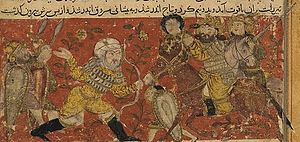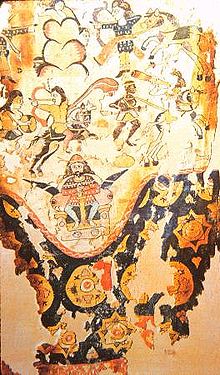Aksumite���Persian wars
| Aksumite–Persian wars | |||||||||
|---|---|---|---|---|---|---|---|---|---|
 Persian miniature from Tarikh-i Bal'ami depicting the Sassanid military general Wahrez killing the Aksumite king Masruq ibn Abraha with an arrow | |||||||||
| |||||||||
| Belligerents | |||||||||
|
Sasanian Empire Himyarite Kingdom | Aksumite Empire | ||||||||
| Commanders and leaders | |||||||||
|
Khosrow I Sayf ibn Dhi-Yazan Wahrez Nawzadh † Ma'd-Karib |
Masruq ibn Abraha † Alla Amidas | ||||||||
| Units involved | |||||||||
| 800 cavalry (Tabari) | 6,000–10,000 troops | ||||||||
The Aksumite–Persian wars were a protracted series of armed engagements between the Sasanian Persian Empire and the Aksumite Ethiopian Empire for control over the waning Himyarite Kingdom in southern Arabia (modern-day Yemen) in the 6th century CE. After a decisive victory at the Battle of Hadhramaut in 570, the Sasanian military marched on and besieged Sana'a, following which the Aksumites were largely expelled from the Arabian Peninsula. The Persians instated the former Himyarite king Sayf ibn Dhī Yazan as the governor of the new Sasanian province of Yemen. However, Yazan was murdered by his Ethiopian slaves four years into his reign, after which the Aksumites tried to re-established their power in the region. Following the death of Yazan, the Sasanian army mounted a second invasion and re-conquered Yemen by 575–578, marking the end of Ethiopian rule in Arabia. After Sasanian control was firmly established in the region, the Persian military general Wahrez was installed as the direct governor of Yemen.
Context[]
This section does not cite any sources. (November 2021) |
Around 520 CE, Kaleb of Aksum sent a military expedition to Yemen to fight against Dhu Nuwas, a Jewish ruler of the Himyarite Kingdom who had gained notoriety for his ongoing persecution of the Christian community in Najran. Following the successful Aksumite invasion, Nuwas was deposed and executed, and Kaleb appointed a Christian Himyarite native, Sumūyafa Ashwa, as his viceroy. However, around 525, Ashwa was deposed by the Aksumite general Abraha, who declared himself as the king of the new Himyarite–Aksumite Kingdom.
After Abraha's death, his son Masruq ibn Abraha continued the Aksumite vice-royalty in Yemen and resumed payment of tribute to the Kingdom of Aksum; he ended the joint Himyarite–Aksumite Kingdom and annexed it to the Aksumite kingdom. Following these events, Masuq's half-brother revolted against him. After being denied aid by Justin II of the Byzantine Empire, Maʽd-Karib sought help from Khosrow I of the Sasanian Persian Empire.
Course of conflict[]
In response to 's request, Khosrow I sent the Sasanian military general Wahrez and his son to Aksumite-ruled Yemen at the head of a small expeditionary force of 800 Dailamite cavalrymen in 570 CE.[1][2] The Sasanian military, onboard eight ships, sailed around the coasts of the Arabian Peninsula; although two of the ships were wrecked, the rest successfully docked in the Hadhramaut region of southern Arabia.[3] The strength of the Sasanian expeditionary force is variously given as 3,600 or 7,500 (Ibn Qutaybah), or 800 (al-Tabari). The Persians sailed from the port of Obolla, seized the Bahrain Islands, and subsequently moved on Sohar, the portside capital of historical Oman; they then captured Dhofar and the remainder of Hadhramaut before landing at Aden.[4]
During the initial invasion, Nawzadh was killed by Aksumite forces.[3] This event led Wahrez to pursue a vendetta against the Ethiopian ruler of Yemen, Masruq ibn Abraha, who was personally executed by Wahrez at the Battle of Hadhramaut. The decisive Persian victory at Hadhramaut marked the beginning of the Aksumite retreat and the subsequent besieging of Sanaʽa by the Persians.

Following the capture of Sanaʽa by Sasanian forces, Wahrez reinstated the former Himyarite king Sayf ibn Dhī Yazan to his throne as a vassal of the Sasanian Persian Empire.[2] Al-Tabari reports that the defining factor of the Persian victory over the Aksumites was the panjagan, a military technology used by the Sasanian military with which the locals were unfamiliar. After the conquest of Yemen and subsequent expulsion of the Ethiopian presence there, Wahrez returned to Persia with a large amount of booty.[5]
Ethiopian uprising and second Persian invasion[]
This section does not cite any sources. (November 2021) |
By 575–578 CE, the Himyarite vassal king Yazan was murdered by his Ethiopian slaves, following which the Aksumites tried to re-established their power in the region. In response, the Sasanian military invaded Yemen a second time, headed by a force of 4000 men and led by Wahrez. Yemen was then annexed by the Sasanian Empire as a province, and Wahrez was installed as its direct governor by the Sasanian emperor Khosrow I. Greater Yemen remained under firm Sasanian control until the rise of the Islamic prophet Muhammad in the early 7th century.
See also[]
- Al-Abnaʽ, obsolete term used to refer to the descendants of Persian military officers and soldiers who intermarried with local Arab women during and after the Aksumite–Persian wars
- Muslim conquest of Persia, 7th-century invasion of Iran by the Rashidun Caliphate
References[]
- ^ electricpulp.com. "ABNĀʾ – Encyclopaedia Iranica". www.iranicaonline.org. Retrieved 13 April 2018.
- ^ a b "Welcome to Encyclopaedia Iranica".
- ^ a b The History of Al-Tabari: The Sasanids, the Lakhmids, and Yemen, p. 240, at Google Books
- ^ Miles, Samuel Barrett (1919). The Countries and Tribes of the Persian Gulf. Harrison and sons. p. 26-29.
- ^ Muhammad and the Origins of Islam, p. 100, at Google Books
Sources[]
- Bosworth, C. E. (1983). "Abnāʾ". Encyclopaedia Iranica, Vol. I, Fasc. 3. pp. 226–228.
- Bowersock, Glen W. (2013). The Throne of Adulis: Red Sea Wars on the Eve of Islam. Oxford University Press. ISBN 978-0-19-973932-5.
- Potts, Daniel T. (2012). "Arabia, ii. The Sasanians and Arabia". Encyclopaedia Iranica.
- Zakeri, Mohsen (1995). Sāsānid Soldiers in Early Muslim Society: The Origins of ʿAyyārān and Futuwwa. Wiesbaden: Otto Harrassowitz. ISBN 978-3-447-03652-8.
- 6th-century conflicts
- Abyssinian–Persian wars
- South Arabia
